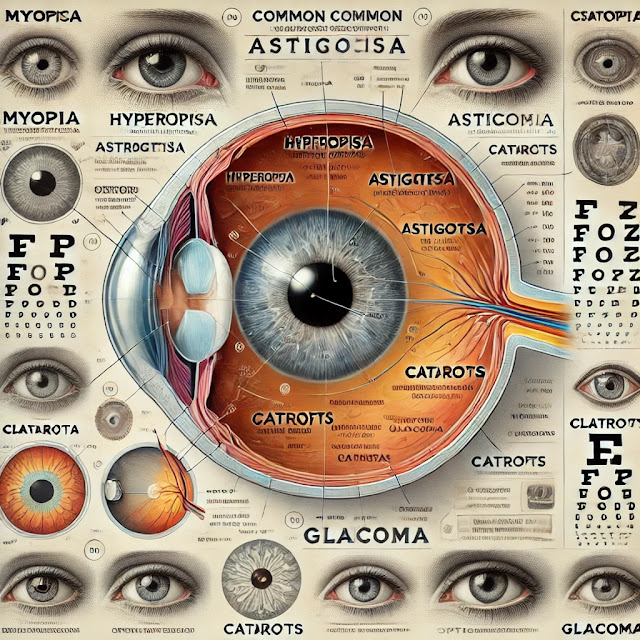Common Eye Conditions Explained: Causes, Symptoms, and Treatments for Healthy Eyes
Discover the causes, symptoms, and treatments for common eye conditions like myopia, hyperopia, astigmatism, cataracts, and glaucoma. Learn how to protect your eye health today!
Header 1 (H1): Common Eye Conditions: Protecting Your Vision for a Lifetime
The human eye is one of the most vital organs, yet many people overlook early signs of vision problems. From refractive errors to sight-threatening diseases, understanding common eye conditions empowers you to take control of your eye health. This comprehensive guide dives deep into the causes, risks, and treatments for myopia, hyperopia, astigmatism, cataracts, and glaucoma—helping you safeguard your vision.
Header 2 (H2): Understanding Eye Anatomy and How Vision Works
Before exploring eye conditions, it’s essential to understand basic eye anatomy:
Cornea: The eye’s clear outer layer that bends light.
Lens: Focuses light onto the retina.
Retina: Converts light into electrical signals for the brain.
Optic Nerve: Transmits visual data to the brain.
When any part of this system malfunctions, vision problems like myopia or glaucoma can develop.
Header 2 (H2): 1. Nearsightedness (Myopia) and Farsightedness (Hyperopia): Causes and Corrections
What Causes Myopia?
Myopia occurs when the eye elongates, forcing light to focus in front of the retina. Risk factors include:
Genetics (family history of eye problems).
Excessive screen time and lack of outdoor activity.
Treatment: Concave lenses, LASIK, or orthokeratology contacts.
Hyperopia: The Hidden Eye Strain
Hyperopia develops when the eye is too short, blurring near objects. Left untreated, it can cause headaches and eye strain.
Header 2 (H2): 2. Astigmatism: Blurred Vision at All Distances
Astigmatism stems from an irregularly shaped cornea, scattering light unevenly. Symptoms include:
Blurred or distorted vision.
Difficulty driving at night.
Fix: Toric lenses, glasses, or LASIK surgery.
Header 2 (H2): 3. Cataracts: Clouding of the Eye’s Lens
Cataracts form when proteins in the eye’s lens clump, causing cloudiness. Key triggers:
Aging (most common cause).
UV exposure, diabetes, or smoking.
Symptom Timeline: Early glare sensitivity → Advanced color fading.
Treatment: Phacoemulsification surgery replaces the lens with an artificial IOL.
Header 2 (H2): 4. Glaucoma: The Silent Threat to Eye Health
Glaucoma damages the optic nerve, often due to high eye pressure. Types include:
Open-Angle Glaucoma: Slow, symptom-free vision loss.
Angle-Closure Glaucoma: Sudden pain and blindness risk.
Why It’s Dangerous: Permanent vision loss without early detection.
Prevention: Regular eye exams to measure intraocular pressure (IOP).
Header 2 (H2): 5. How to Protect Your Eye Health Daily
Wear Sunglasses: Block 100% of UVA/UVB rays to reduce cataract risk.
Follow the 20-20-20 Rule: Reduce digital eye strain during screen use.
Eat Eye-Healthy Foods: Spinach (lutein), salmon (omega-3s), and carrots (vitamin A).
Quit Smoking: Lowers risk of cataracts and macular degeneration.
Header 2 (H2): FAQs About Common Eye Conditions
Q: How often should I get an eye exam?
A: Adults: Every 2 years. Diabetics or those with eye conditions: Annually.
Q: Can eye exercises improve vision?
A: No, but they may reduce strain. Refractive errors require medical correction.
Q: Are blue light glasses good for eye health?
A: They reduce digital strain but don’t prevent permanent damage.
Header 2 (H2): When to See an Eye Doctor: Warning Signs
Seek immediate care if you experience:
Sudden vision loss or flashes of light.
Severe eye pain or redness.
Double vision or halos around lights.
Header 1 (H1): Conclusion: Prioritize Your Eye Health Today
Your eyes are irreplaceable. By understanding common eye conditions, adopting preventive habits, and scheduling regular exams, you can protect your vision for years to come. Share this guide to spread awareness about eye health!

